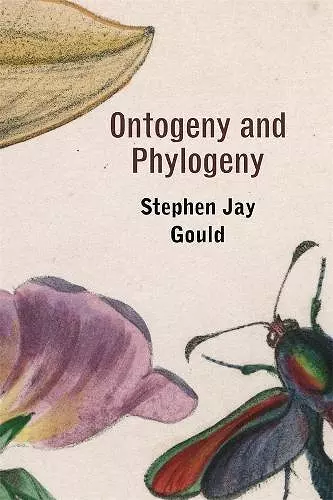Ontogeny and Phylogeny
Format:Paperback
Publisher:Harvard University Press
Published:16th Feb '85
Should be back in stock very soon

A distinguished and pioneering work. -- Ernst Mayr
“Ontogeny recapitulates phylogeny” was Haeckel’s answer to 19th-century biology’s most vexing question: what is the relationship between individual development and the evolution of species and lineages? Gould documents the history of the idea of recapitulation from its first appearance among the pre-Socratics to its fall in the early 20th century.
“Ontogeny recapitulates phylogeny” was Haeckel’s answer—the wrong one—to the most vexing question of nineteenth-century biology: what is the relationship between individual development (ontogeny) and the evolution of species and lineages (phylogeny)? In this, the first major book on the subject in fifty years, Stephen Jay Gould documents the history of the idea of recapitulation from its first appearance among the pre-Socratics to its fall in the early twentieth century.
Mr. Gould explores recapitulation as an idea that intrigued politicians and theologians as well as scientists. He shows that Haeckel’s hypothesis—that human fetuses with gill slits are, literally, tiny fish, exact replicas of their water-breathing ancestors—had an influence that extended beyond biology into education, criminology, psychoanalysis (Freud and Jung were devout recapitulationists), and racism. The theory of recapitulation, Gould argues, finally collapsed not from the weight of contrary data, but because the rise of Mendelian genetics rendered it untenable.
Turning to modern concepts, Gould demonstrates that, even though the whole subject of parallels between ontogeny and phylogeny fell into disrepute, it is still one of the great themes of evolutionary biology. Heterochrony—changes in developmental timing, producing parallels between ontogeny and phylogeny—is shown to be crucial to an understanding of gene regulation, the key to any rapprochement between molecular and evolutionary biology. Gould argues that the primary evolutionary value of heterochrony may lie in immediate ecological advantages for slow or rapid maturation, rather than in long-term changes of form, as all previous theories proclaimed.
Neoteny—the opposite of recapitulation—is shown to be the most important determinant of human evolution. We have evolved by retaining the juvenile characters of our ancestors and have achieved both behavioral flexibility and our characteristic morphology thereby (large brains by prolonged retention of rapid fetal growth rates, for example).
Gould concludes that “there may be nothing new under the sun, but permutation of the old within complex systems can do wonders. As biologists, we deal directly with the kind of material...
In Gould’s…new book…Ontogeny and Phylogeny, a scholarly study of the theory of recapitulation, he not only explains scientific theory but comments on science itself, with clarity and wit, simultaneously entertaining and teaching… [This] is a rich book. -- James Gorman * New York Times Book Review *
Steven Jay Gould has given us a superb analysis of the use of ontogenetic analogy, the controversies over ontogeny and phylogeny, and the classification of the different processes observable in comparing different ontogenies. His massive book (in each chapter of which there is as much material as in whole books by other writers) is both a historical exposition of the whole subject of ontogeny and phylogeny, and…a fascinating attempt at a functional interpretation of those phylogenetic alterations that involve changes of timing developmental processes in related organisms. -- A. J. Cain * Nature *
This [is a] fat, handsome book crammed with provocative ideas… Ontogeny and Phylogeny is an important and thoughtful book which will be a valuable source of ideas and controversies for anyone interested in evolutionary or developmental biology. -- Matt Cartmill * Science *
It is rare indeed to read a new book and recognize it for a classic… Gould has given biologists a new way to see the organisms they study. The result is a major achievement. -- S. Rachootin * American Scientist *
Gould’s book—pervaded, I should say, with an erudition and felicity of style that make it a delight to read—is a radical work in every sense… It returns one’s attention to the roots of our science—the questions about the great pageant of evolution, the marvelous diversity of form that our theory is meant to explain. -- D. Futuyma * Quarterly Review of Biology *
A distinguished and pioneering work. -- Ernst Mayr
ISBN: 9780674639416
Dimensions: unknown
Weight: 644g
520 pages